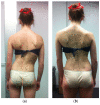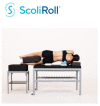The Improvement of Trunk Muscle Endurance in Adolescents with Idiopathic Scoliosis Treated with ScoliBrace® and the ScoliBalance® Exercise Approach
- PMID: 38337346
- PMCID: PMC10856658
- DOI: 10.3390/jcm13030653
The Improvement of Trunk Muscle Endurance in Adolescents with Idiopathic Scoliosis Treated with ScoliBrace® and the ScoliBalance® Exercise Approach
Abstract
The impact of scoliosis bracing combined with physiotherapeutic scoliosis-specific exercises (PSSE) on trunk muscle endurance in adolescents with idiopathic scoliosis is unknown. ScoliBrace®, a rigid, three-dimensional, over-corrective thoraco-lumbar-sacral orthosis (TLSO), and ScoliBalance®, a PSSE program, were used to treat adolescent idiopathic scoliosis (AIS) patients. A retrospective study of the trunk muscle endurance of 33 AIS patients who received ScoliBrace® and ScoliBalance® was conducted. The patients were treated with ScoliBrace® and an individualized ScoliBalance® program. Trunk extensor muscle endurance (TE) and abdominal muscle endurance (AE) tests were performed at initial assessment and then at averages of 6.6 and 24.4 weeks of treatment. The data were analyzed using the Wilcoxon signed-rank test, Stata version 15.1. The participants were aged 13.24 years (SD = 1.64) with a mean Cobb angle of 38.97° (SD = 9.49°). TE improved significantly (p < 0.001) at both short- and medium-term intervals using ScoliBalance® and ScoliBrace® in the AIS patients. AE also showed significant improvement between baseline and short-term follow-up, with non-significant improvement at medium-term follow-up. Overall, trunk muscle endurance showed improvement in the AIS patients using ScoliBrace® and ScoliBalance®. Future research is required to determine the individual and combined effects of each treatment. However, it seems likely that trunk muscle endurance will not deteriorate in AIS patients with this combined treatment.
Keywords: adolescents; endurance; exercise; idiopathic scoliosis; scoliosis; trunk muscle.
Conflict of interest statement
J.M. is the owner and director of ScoliCare, a company that provides scoliosis care described in this paper (ScoliBalance® and ScoliBrace®). J.M. and R.M. are developers and trainers of the ScoliBalance® approach. J.M., R.M., J.D. and T.P. are all paid employees of ScoliCare. There are no other conflicts of interest to declare.
Figures







Similar articles
-
A Non-Surgical Multimodal Approach to Severe Thoracic Adolescent Idiopathic Scoliosis Combining ScoliBrace and Scoliosis-Specific Rehabilitation Therapies: A Case Series.Healthcare (Basel). 2025 Jun 26;13(13):1522. doi: 10.3390/healthcare13131522. Healthcare (Basel). 2025. PMID: 40648546 Free PMC article.
-
The Efficacy of Trunk Bracing With an Instrumented Corrective Exercise on Spinal Deformity, Pulmonary Function, Trunk Muscle Endurance, and Quality of Life in Adolescent Idiopathic Scoliosis: Protocol for a Parallel Groups Clinical Study.JMIR Res Protoc. 2023 Mar 29;12:e43265. doi: 10.2196/43265. JMIR Res Protoc. 2023. PMID: 36989018 Free PMC article.
-
The efficacy of combined physiotherapeutic scoliosis-specific exercises and manual therapy in adolescent idiopathic scoliosis.BMC Musculoskelet Disord. 2024 Oct 31;25(1):874. doi: 10.1186/s12891-024-07974-1. BMC Musculoskelet Disord. 2024. PMID: 39482645 Free PMC article. Clinical Trial.
-
Management of Spinal Deformities and Evidence of Treatment Effectiveness.Open Orthop J. 2017 Dec 29;11:1521-1547. doi: 10.2174/1874325001711011521. eCollection 2017. Open Orthop J. 2017. PMID: 29399227 Free PMC article. Review.
-
Effects of Physiotherapeutic Scoliosis-Specific Exercise for Adolescent Idiopathic Scoliosis Cobb Angle: A Systematic Review.Spine Surg Relat Res. 2024 Dec 10;9(2):120-129. doi: 10.22603/ssrr.2024-0191. eCollection 2025 Mar 27. Spine Surg Relat Res. 2024. PMID: 40223832 Free PMC article. Review.
Cited by
-
Compliance of Physiotherapeutic Scoliosis-Specific Exercise in Adolescent Idiopathic Scoliosis: A Scoping Review.J Clin Med. 2025 Apr 24;14(9):2950. doi: 10.3390/jcm14092950. J Clin Med. 2025. PMID: 40363981 Free PMC article. Review.
-
Wearable Devices in Scoliosis Treatment: A Scoping Review of Innovations and Challenges.Bioengineering (Basel). 2025 Jun 25;12(7):696. doi: 10.3390/bioengineering12070696. Bioengineering (Basel). 2025. PMID: 40722388 Free PMC article. Review.
-
A Non-Surgical Multimodal Approach to Severe Thoracic Adolescent Idiopathic Scoliosis Combining ScoliBrace and Scoliosis-Specific Rehabilitation Therapies: A Case Series.Healthcare (Basel). 2025 Jun 26;13(13):1522. doi: 10.3390/healthcare13131522. Healthcare (Basel). 2025. PMID: 40648546 Free PMC article.
-
Effectiveness of Schroth exercises for adolescent idiopathic scoliosis: a meta-analysis.PeerJ. 2025 Jul 8;13:e19639. doi: 10.7717/peerj.19639. eCollection 2025. PeerJ. 2025. PMID: 40656945 Free PMC article.
-
Schroth and Asymmetric Spinal Stabilization Exercises' Effectiveness on Back Pain and Trunk Muscle Endurance in Adolescents' Idiopathic Scoliosis: A Randomized Controlled Trial.Med J Islam Repub Iran. 2024 Aug 6;38:90. doi: 10.47176/mjiri.38.90. eCollection 2024. Med J Islam Repub Iran. 2024. PMID: 39678764 Free PMC article.
References
-
- Lenz M., Oikonomidis S., Harland A., Fürnstahl P., Farshad M., Bredow J., Eysel P., Scheyerer M.J. Scoliosis and Prognosis—A systematic review regarding patient-specific and radiological predictive factors for curve progression. Eur. Spine J. 2021;30:1813–1822. doi: 10.1007/s00586-021-06817-0. - DOI - PubMed
-
- Negrini S., Hresko T.M., O’brien J.P., Price N., Boards S., Committee S.N.-O. Recommendations for research studies on treatment of idiopathic scoliosis: Consensus 2014 between SOSORT and SRS non–operative management committee. Scoliosis. 2015;10:8. doi: 10.1186/s13013-014-0025-4. - DOI - PMC - PubMed
LinkOut - more resources
Full Text Sources

